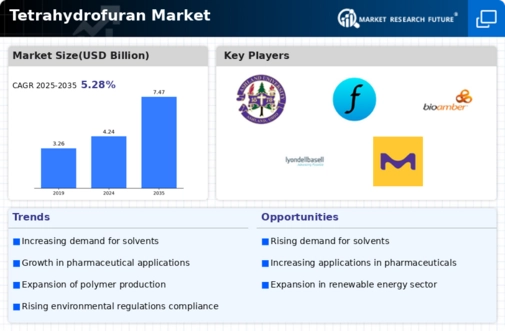Market Analysis
In-depth Analysis of Tetrahydrofuran Market Industry Landscape
The Tetrahydrofuran (THF) market is characterized by dynamic forces that shape its growth and performance. THF, a crucial industrial solvent with diverse applications, experiences fluctuations in demand and supply, influenced by several market dynamics. One key factor is the product's extensive use in the production of polymers, resins, and elastomers. As these industries undergo shifts in demand, the THF market adjusts accordingly. The automotive and construction sectors, major consumers of polymers, significantly impact the market dynamics. Economic trends and consumer behavior directly affect these end-user industries, creating a ripple effect on THF demand.
The growing demand from the Ether Glycol segment will create exceptional growth opportunities. Tetrahydrofuran is widely used in the production of polytetramethylene ether glycol. It is a chemical base for various plastic. Production of polyurethanes is possible through this proves. The demand from this segment is predicted to increase in the forthcoming years.
More than 65 per cent of the world's Tetrahydrofuran is utilized to create other forms of plastics and polytetramethylene. Also, the production of spandex and other polyurethanes use this component on large scale. During the forecast period, the market for Tetrahydrofuran is the growing use of polytetramethylene. The rising demand from the energy market is another growth factor in this market. Developing nations such as the Asia Pacific has a high need for reliable energy sources.
Moreover, the THF market is closely tied to the chemical industry, as it serves as a precursor in the synthesis of various chemicals. The pharmaceutical sector, for instance, relies on THF for manufacturing certain drugs, adding another layer of complexity to market dynamics. Regulatory changes in the pharmaceutical and chemical industries can directly influence the THF market, impacting production processes and supply chains. The market is also susceptible to environmental regulations, as THF is subject to scrutiny due to its potential environmental impact. Stringent regulations may necessitate changes in production methods, affecting costs and overall market dynamics.
Global trade dynamics play a pivotal role in shaping the THF market, given its widespread use and production across different regions. Fluctuations in currency exchange rates, trade tariffs, and geopolitical tensions can impact the cost of raw materials and the pricing of THF in the international market. Supply chain disruptions, such as those witnessed during the COVID-19 pandemic, highlight the vulnerability of the THF market to unforeseen external shocks. As the world becomes more interconnected, events in one part of the globe can have cascading effects on the entire THF supply chain.
Innovation and technological advancements also contribute to the market dynamics of THF. Continuous research and development lead to the discovery of alternative production methods and applications, influencing market competition. Companies investing in more efficient and sustainable production processes gain a competitive edge, affecting market share and overall industry dynamics. The emergence of bio-based THF, for example, introduces a new dimension to the market, challenging traditional petrochemical-based production methods and altering the competitive landscape.
Market dynamics are further shaped by the price volatility of key raw materials used in THF production, such as butanediol. Fluctuations in the prices of these raw materials directly impact the cost of THF production, influencing pricing strategies and profitability for manufacturers. The availability and pricing of these raw materials are subject to factors like natural disasters, geopolitical events, and market speculation, adding an element of unpredictability to the THF market.









Leave a Comment